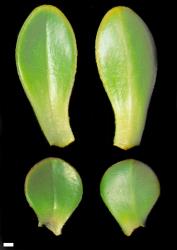- ≡ Hebe macrocalyx (J.B.Armstr.) G.Simpson, Trans. Roy. Soc. New Zealand 79: 427 (1952)
Spreading low shrub to 0.2 m tall. Stems prostrate to decumbent, eglandular-puberulent or glabrous; hairs bifarious. Leaf bud distinct, its outer leaves fully grown, diverging. Leaves opposite-decussate to sub-distichous, connate in pairs and encircling stem, erecto-patent to spreading; lamina coriaceous or fleshy, obovate to spathulate or ovate, elliptic, or rhomboid, 4–16 mm long, 2–9 mm wide, dull to glossy green above and beneath, midrib faint; surfaces glabrous; margins glabrous or glandular-ciliolate to minutely papillate or erose, entire or rarely with a few shallow teeth; apex obtuse or rounded or retuse; base cuneate; petiole indistinct, 1–5 mm long. Inflorescence a terminal very compact compound spike, 5–43 mm long; flowers crowded, 2–12 in each of terminal and 2–12 lateral spikes, female or bisexual on separate plants, ⚥ > ♀; bracts opposite below, becoming alternate, linear to lanceolate or deltoid, ≤ calyx; pedicels absent. Calyx lobes 4–5 (5th lobe small, posterior), obtuse to sub-acute or occasionally acute, 4.0–8.5 mm long, unequal, glabrous or minutely mixed glandular and eglandular ciliolate. Corolla 3.5–8.0 mm diameter; tube white, 2.5–6.5 mm long, < to > calyx, glabrous. Corolla lobes 4, white, spreading to recurved, sub-equal to unequal, elliptic to orbicular or rhomboid, 2–3 mm long, sub-acute to obtuse; nectar guides absent. Stamen filaments white, 0.5–1.3 mm long, pink or magenta. Style glabrous, 3–8 mm long. Capsules latiseptate, acute to sub-acute, glabrous, 3.5–5.5 mm long, 2.0–3.5 mm at widest point. Seeds ellipsoid to discoid, flattened, smooth, straw-yellow, 0.7–1.0 mm long.
| 1 | Keel of lamina extending to apex; margin papillate and/or erose, reddish; calyx lobes red-tipped | var. humilis |
| Keel of lamina terminating short of apex; margins smooth or sometimes weakly erose towards apex, green or translucent; calyx lobes green-tipped | var. macrocalyx |
V. macrocalyx is most similar to V. haastii and V. kellowiae. V. haastii plants differ by their broad, sessile, and often toothed leaves, broader and shorter calyx lobes and broader capsules. V. kellowiae plants differ by their simpler inflorescences with fewer lateral branches, and the terminal and lateral branches slightly stalked; they are generally much smaller. V. macrocalyx plants often grow with or near plants of V. epacridea, which have strongly keeled rigid and persistent leaves, thickened leaf margins, and long, fringing marginal hairs on bracts and calyx lobes.
Plants of two species from Southland and Otago, V. murrellii and V. petriei, have similar growth forms, but differ in their simple terminal spikes of always alternate flowers. Also, V. murrellii plants have short corolla tubes and far-exserted anthers, and V. petriei plants have sterile bracts at the base of the inflorescence.
South Island: Western Nelson, Sounds Nelson, western Marlborough, Westland, Canterbury (north of Mt Harman).
Alpine herb-fields in rock debris and scree. Recorded elevations range from 1080 to 1908 m.
| Category | Number |
|---|---|
| Indigenous (Endemic) | 2 |
| Total | 2 |
Flowers: September–March; fruits: November–April, persisting all year.
2n = 42 (see Bayly & Kellow 2006, as Hebe macrocalyx).
Veronica macrocalyx is classified in V. subg. Pseudoveronica sect. Hebe and the informal group “Connatae” (Albach & Meudt 2010; Bayly & Kellow 2006).
Along with V. haastii, V. epacridea, and V. kellowiae, V. macrocalyx is one of a small clade that is sister to V. odora and V. pauciramosa, based on ITS sequence data (E.M. Low, unpublished).




